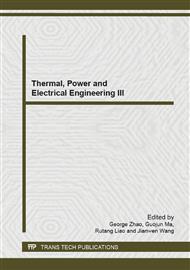[1]
Qiu G. Selection of working fluids for micro-CHP systems with ORC. Renewable Energy 48(2012)565–70.
DOI: 10.1016/j.renene.2012.06.006
Google Scholar
[2]
Junjiang Bao, Li Zhao,A review of working fluid and expander selections for organic Rankine cycle;Renewable and Sustainable Energy Reviews 24 (2013) 325–342.
DOI: 10.1016/j.rser.2013.03.040
Google Scholar
[3]
Roy JP, Mishra MK, Misra A. Parametric optimization and performance analysis of a waste heat recovery system using Organic Rankine Cycle. Energy 2010, 35(12)5049–62.
DOI: 10.1016/j.energy.2010.08.013
Google Scholar
[4]
Maraver D, Uche J, Royo J. Assessment of high temperature organic Rankine cycle engine for poly generation with MED desalination: A preliminary approach. Energy Conversion and Management 2012; 53(1): 108–17.
DOI: 10.1016/j.enconman.2011.08.013
Google Scholar
[5]
Sébastien Declaye, Sylvain Quoilin, Experimental study on an open-drive scroll expander integrated into an ORC (Organic Rankine Cycle) system with R245fa as working fluid[J],Energy 55 (2013) 173-183.
DOI: 10.1016/j.energy.2013.04.003
Google Scholar
[6]
Seok Hun Kang,Design and experimental study of ORC (organic Rankine cycle) and radial turbine using R245fa working fluid [J], Energy 41 (2012) 514-524.
DOI: 10.1016/j.energy.2012.02.035
Google Scholar
[7]
Musbaudeen Bamgbopa, Eray Uzgoren, Quasi-dynamic model for an organic Rankine cycle [J], Energy Conversion and Management 72 (2013) 117–124.
DOI: 10.1016/j.enconman.2013.01.040
Google Scholar
[8]
Noboru Yamada, Md Nor Anuar Mohamad, Trinh Trung Kien, Study on thermal efficiency of low- to medium-temperature organic Rankine cycles using HFO1234yf [J], Renewable Energy 41 (2012) 368-375.
DOI: 10.1016/j.renene.2011.11.028
Google Scholar
[9]
S. Quoilin, S. Declaye, Organic rankine cycle systems: a techno-economic overview, Proceedings of EMC (2013).
Google Scholar
[10]
Tom Howel,Development of an ORC system to improve HD truck fuel efficiency, DEER 2011 CONFERENCE.
Google Scholar
[11]
Paola Bombarda, Costante M. Invernizzi, Claudio Pietra,Heat recovery from Diesel engines: A thermodynamic comparison between Kalina and ORC cycles [J],Applied Thermal Engineering 30 (2010) 212–219.
DOI: 10.1016/j.applthermaleng.2009.08.006
Google Scholar


